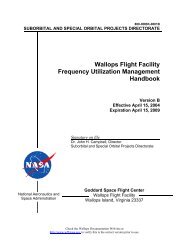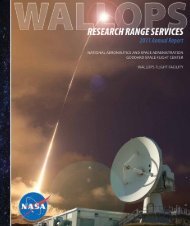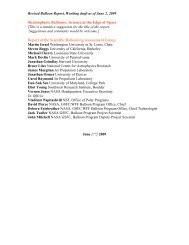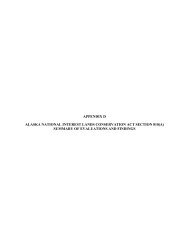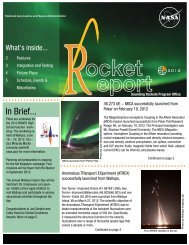Alternative Energy Draft EA - NASA Visitor Center at Wallops Flight ...
Alternative Energy Draft EA - NASA Visitor Center at Wallops Flight ...
Alternative Energy Draft EA - NASA Visitor Center at Wallops Flight ...
Create successful ePaper yourself
Turn your PDF publications into a flip-book with our unique Google optimized e-Paper software.
Summer–Fall 2008 B<strong>at</strong> Study <strong>at</strong> <strong>Wallops</strong> Island<br />
Affected Environment<br />
Between July 15 and October 21, 2008, passive acoustic b<strong>at</strong> surveys were conducted on <strong>Wallops</strong><br />
Island in the area of the proposed wind turbines to document b<strong>at</strong> activity and identify species th<strong>at</strong><br />
occur in the area (Appendix B). Four Anab<strong>at</strong>® acoustic detectors deployed <strong>at</strong> the proposed wind<br />
turbine site (see Figure 12) collected d<strong>at</strong>a over 229 nights of recordings. Two detectors were<br />
placed in an existing 50-meter (164-foot) unguyed tower (the same tower as the “South<br />
Boresight Tower” in the previous sections), which is loc<strong>at</strong>ed approxim<strong>at</strong>ely 427 meters (1,400<br />
feet) south of the proposed wind turbine site, and two were situ<strong>at</strong>ed on 10-meter (33-foot) poles<br />
in adjacent marshlands.<br />
A total of 2,140 b<strong>at</strong> call sequences were recorded during the sampling period. The mean<br />
detection r<strong>at</strong>e of all detectors was 9.3 detections per night. The highest detection r<strong>at</strong>e was 15.9<br />
detections per night, and the lowest r<strong>at</strong>e was 2.4 detections per night. B<strong>at</strong> calls were identified to<br />
the lowest possible taxonomic level, and were then grouped into six guilds based on similarity in<br />
call characteristics between some species and the uncertainty in the ability of frequency division<br />
detectors to adequ<strong>at</strong>ely provide inform<strong>at</strong>ion for this differenti<strong>at</strong>ion. The six guilds are described<br />
below.<br />
Unknown – All call sequences with too few pulses (less than five) or of poor quality<br />
(such as indistinct pulse characteristics or background st<strong>at</strong>ic).<br />
Myotid – All b<strong>at</strong>s of the genus Myotis. While there are some general characteristics<br />
believed to be distinctive for several of the species in this genus, these characteristics do<br />
not occur consistently enough for any one species to be relied upon <strong>at</strong> all times when<br />
using Anab<strong>at</strong>® recordings.<br />
Eastern red b<strong>at</strong>s, eastern pipistrelles, evening b<strong>at</strong>s (RBEP) – These three species can<br />
produce calls distinctive only to each species. However, significant overlap in the call<br />
pulse shape, frequency range, and slope can also occur.<br />
Big brown/silver-haired b<strong>at</strong> (BBSH) – These species’ call sign<strong>at</strong>ures commonly overlap<br />
and were therefore included as one guild.<br />
Hoary b<strong>at</strong> – Calls of hoary b<strong>at</strong>s can usually be distinguished from those of big brown and<br />
silver-haired b<strong>at</strong>s. Hoary b<strong>at</strong>s are easily identified by calls varying in minimum frequency<br />
across a sequence.<br />
Big-eared b<strong>at</strong>– Known as “whispering b<strong>at</strong>s,” this species emits low-intensity calls and<br />
listens for insect-gener<strong>at</strong>ed sounds while foraging close to the ground; detecting calls of<br />
these b<strong>at</strong>s is therefore difficult. Calls of big-eared b<strong>at</strong>s are not easily confused with calls<br />
of any other species th<strong>at</strong> may coexist on <strong>Wallops</strong> Island.<br />
Nightly call volumes varied over the survey period. Call volumes peaked between August 13 and<br />
August 16, with the gre<strong>at</strong>est number of sequences (223) recorded on August 15. Sequences<br />
within the RBEP, BBSH, unknown, and to a lesser extent hoary b<strong>at</strong> guilds accounted for these<br />
peaks. On August 15, the majority of sequences (46.6 percent) identified to species belonged to<br />
eastern red b<strong>at</strong>s. High frequency unknowns likely to be eastern red b<strong>at</strong>s or eastern pipistrelles<br />
accounted for 44.4 percent of sequences recorded on August 15.<br />
65







